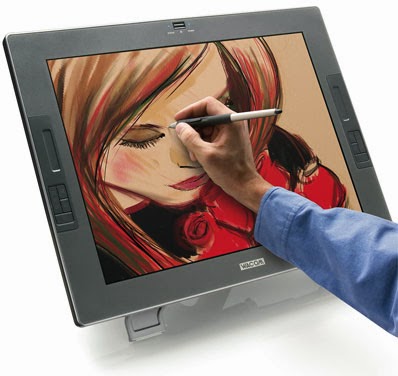In my lifetime I've seen a number of things change. I remember when vinyl records became CD's, and CD's became MP3s. I remember when telephones had busy signals before call waiting, when rotary dials were replaced with buttons, and when landlines became cell phones. I remember when models used to be built by hand and now they can be build 3D in a computer program. Technology changes the world around us, but that doesn't affect how someone draws, does it? While the basic principles of art stay the same, the materials change. For example,
Leonardo Da Vinci never owned a pencil. It didn't exist in his lifetime. Leonardo drew with chalk.
For those of us who live in the 21st Century, it's the computer that effects everything. This includes drawing. There is a ton of digital art being produced. I experimented with digital painting myself when I produced my Christmas card last year.
 |
| This illustration was painted completely digitally |
I had never really considered line drawing on the computer until recently. The idea of it intrigued me so I looked into it. What I found was this, there are two ways to do it using either a C
intiq, or a
Wacom Bamboo Tablet.
Both devices are plugged into the computer. With a Cintiq, the user literally draws on a screen as if they were drawing on a sheet of paper. It's like having a digital drawing board.
 |
This is how a Cintiq works
The Wacom is a little different. The user draws on a pad, but needs to look at a separate computer screen while drawing on the separate pad. A Wacom operates in much the same way as a mouse. Both the Cintiq and the Wacom have their advantages and disadvantages.
|
 |
| This is a Wacom Bamboo |
For my purposes I decided to work with a Wacom tablet. I started experimenting the same way I started drawing way back when. I pulled out my
George Bridgeman book and started drawing from it. It took me a while before a realized that the way to go was to do my "roughs" in "blue pencil" and then the next stage with a "2B pencil".
 |
| The rough |
 |
| The finish |
 |
| Done with blue "pencil" |
 |
| The finish on top of the blue |
There are things I have yet to learn with this.
After my initial drawings I decided to do my comic book roughs completely digital. Here's the result:
 |
| My blueline digital rough |
 |
| my second more finished digital rough |
 |
| The final drawn on bristol board by hand |
Once the roughs were finished and approved, I finished them up the usual way. I prefer to have the finish be by hand - at least for right now.
For more information on digital comic book illustration, check out the excellent book by
Freddie E. Williams,
The DC Comics Guide To Digitally Drawing Comics.










